Photos with this report (click to enlarge) | |||
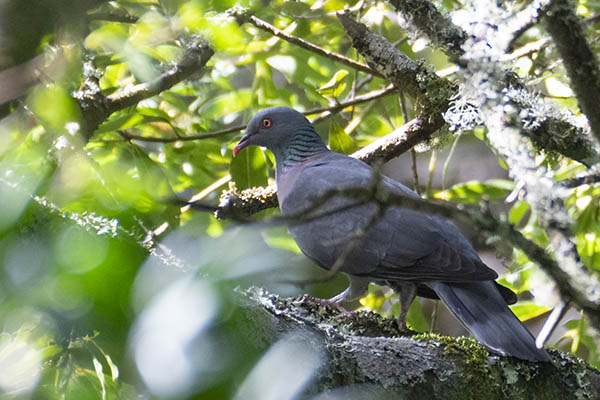 Bolle's Pigeon |
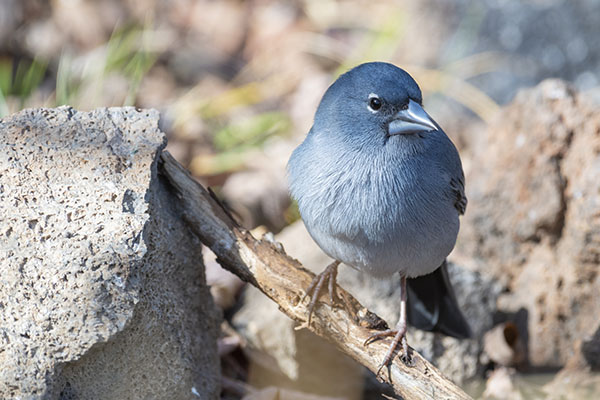 Blue Chaffinch |
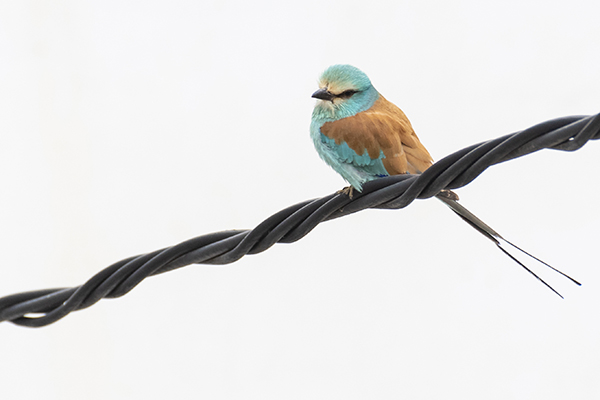 Abyssinian Roller |
|
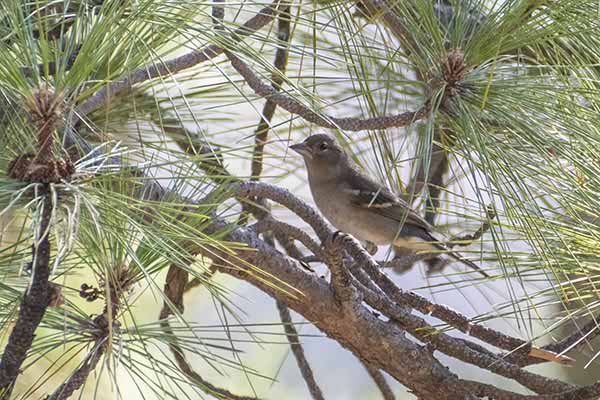 Gran Canaria Blue Chaffinch |
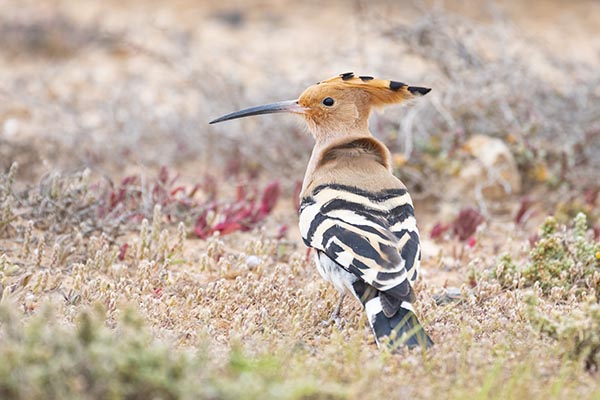 Eurasian Hoopoe |
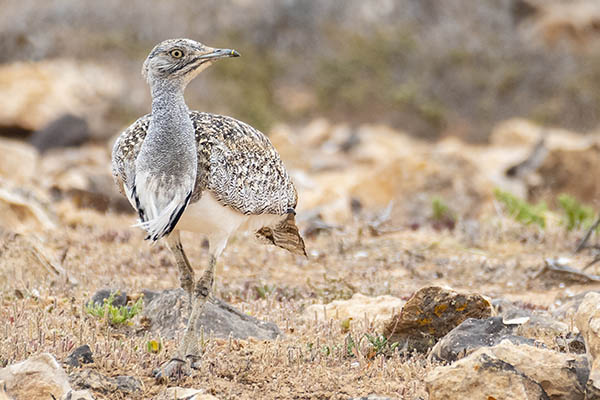 Houbara Bustard |
|
The following trip report comprises an 18-day trip to the Canary Islands, to be precise, the islands of La Palma, Tenerife, Gran Canaria and Fuerteventura.
You can DOWNLOAD this report as pdf with links to ALL LOCATIONS and detailed SPECIES LIST including locations here: Trip report PDF
A round trip to these four islands should be sufficient to see most of the Canary Island specialities, even though you surely miss some of the other islands’ subspecies. The aim of our trip was to see most of the endemics, but we also planned plenty of time for activities other than birding.
We saw all possible endemics and specialities except for Barolo’s Shearwater and Slender-billed Barn Owl.
General advice
Flights from abroad
On 7th Feburary, 2020 we took our flight from Vienna, via Madrid, to Santa Cruz de la Palma. Regarding the flights, we found out that it can be much cheaper to book the tickets directly at the airline (in our case Iberia) and pay for luggage extra.
Rental cars
We had also booked a rental car in advance, which are easily available at an acceptable price. If you plan to take the car with you by ferry, be sure to pay the extra fare in advance to avoid any fines. It is also no problem to return the car on any other of the bigger islands in the archipelago. As always, take care to bring enough cash or a big credit card limit to pay the deposit.
Inter-island transport
For reasons of practicability and eco-friendliness we decided to use the same car for all four islands and cross by ferry (which is, additionally, a nice opportunity for sea-watching) instead of flying every time. The ferry tickets can be booked at the providers websites (Fred Olsen & Armas) and are approx. 60-100 € per crossing (car + 2 people), depending on the time of day.
Hotels, language etc.
Hotels are readily bookable on various websites, we booked only one to two days in advance to be as flexible as possible.
As tourism thrives in many parts of the archipelago, you will easily find anybody speaking English in case you need any advice or help.
One last general advice: If going by car, drive carefully. The islands are highly mountainous, and many drivers race down the streets quite ambitiously.
Trip itinerary
La Palma
07/02/2020: arrival in the afternoon at SC de la Palma airport; visited the city of Santa Cruz and beach, no real birding; From the apartment window we already heard and saw Atlantic Canary, Canary Island Chiffchaff, Sardinian Warbler, semi-wild Rock Pigeons, Common Kestrel (F. t. canariensis). All of them are common in open areas on the island. Grey Wagtail (M. c. canariensis) was present at the accommodation as well as in the centre of SC.
08/02/2020: In the morning we visited the Laurel Forest of Los Tiles (maybe the most visited and famous part of Laurel forest on the island, situated near Los Sauces) to see some of the woodland species. Bolle’s Pigeon (Columba bollii) is quite common here and you will probably see some while hiking through the forest. Indeed, in my experience, one the easiest places to observe this species is the powerline crossing on the way to Los Tiles, approx. 2,5 km after leaving the main road. There, we could observe a flock of at least 10-15 birds, including freshly fledged youngs fed by their parents. Worth mentioning however, that there were no birds on the wire at mid-day, so we would suggest an early or late visit to enlarge your chances. I guess they avoid the heat because at my former visit in August 2012 it was not easy to see. Nevertheless, the species is common on LP, so you should definitely see them flying above the tree tops, if you do some scanning stops along the road in the northeastern part of the island.
Around the Los Tiles visitor centre, some species are easily observable: La Palma race of Chaffinch (F. c. palmae) (will eventually eat out of your hand), Blackbird (T. m. cabrerae), Palma Blue Tit (C. t. palmensis), Blackcap & C I Chiffchaff.
Western Canary Islands goldcrest (R. (r.) ellenthalerae) was probably the most elusive of the widespread forest species, but we managed to get some brief looks (attention to the high pitched calls!).
After leaving the Los Tiles forest we headed further north. We visited the Laguna de Barlovento, a huge freshwater reservoir (you’ll definitely need a scope!), which was leaking at the moment due to geological activity. That means there is not much water in it, but therefore it provides a nice environment for waders and dabbling ducks. On this visit, we counted at least 17 Coots, 2 female Teals (Anas crecca/carolinensis) and some Atlantic Yellow-legged Gulls. You’ll find good vantage points on both sides of the street on the north side of the reservoir (28.813578, -17.807057).
The open country west of Barlovento around La Tosca is also worth a visit due to some very impressive dragon trees. There you will also encounter Atlantic Canary, C.I. Chiffchaff and probably “Graja” / Red-billed Chough. You can also check the Laurel forest south of La Tosca (28.820533, -17.821829), which proved good for some forest species incl. Bolle’s Pigeon.
09/02/2020: In the morning we crossed the Cumbre Vieja (the central range) along the LP-301. We saw our first Berthelot’s Pipit together with a Common Raven near El Pilar. At the roundabout next to the “Caldera de Taburiente” visitors center, a pair of Graja / Red-billed Chough showed exceptionally well.
In Puerto de Tazacorte we took a whale watching tour, which can be good for seabirds. We saw some Cory’s Shearwaters and a few Northern Gannets off shore. While re-entering the harbour, my partner Ines pointed out a duck, which subsequently turned out to be a Common Scoter. As I found out afterwards this 2nd island record had already been discovered in December 2019. Due to the busy surroundings, the bird was really tame and gave us the best views we ever had on this species.
Afterwards we checked the plenty freshwater reservoirs along Camino Martelas de Abajo (28.640729, -17.913289) south of Los Llanos and the nearby Laguna in Dos Pinos. The different pools provided us with a variety of water birds, including Grey Heron, Little Egret, Spoobill, Greenshank, Atlantic YLG and the only Black-headed Gulls of the trip.
10/02/2020: We visited the volcanoes on the south tip of La Palma and the Salinas de Fuencaliente. Although there were no rare shorebirds, the saline ponds showed their potential by containing a nice flock of Turnstones (min. 20). Unfortunately, sea-watching was completely redundant, as strong winds hit the coast that day.
The reservoirs near Los Llanos did not provide any new birds. In the city itself, a Sparrowhawk (A. n. granti) raced down the main street hunting passerines.
11/02/2020: After driving up the east slope of Caldera de Taburiente on the LP-4, we walked to the summit of Pico de las Nieves. We started from the parking lot, which is, coming from Santa Cruz, situated on the left side c. 25 km after leaving the LP-1. On the summit you will probably encounter tame Ravens and the forest along the track holds some Palma Chaffinches and Western C.I. Goldcrests. If interested in archaeology, don’t miss the short detour to the rock engravings south of the summit. The visit to Roque de los Muchachos was not productive in an ornithological sense. Nevertheless, if you have the time, take the LP-4 all the way down to Hoya Grande, the impressive volcanic rock and sediment formations will pay you off. The archaeological park of La Zarza, which we came to see afterwards, provided at least some Robins, Blackbirds and Blackcaps. By the way, the northwest of the island is extraordinarily beautiful in early spring due to the almond blossom and a very green scenery.
Tenerife
12/02/2020: We took the Fred Olsen ferry to Tenerife, departing well before dawn. After a short stop at La Gomera, the light was sufficient for a little bit of sea-watching and the waters between Gomera and Tenerife presented at least a few Cory’s Shearwaters, the biggest flock numbering at least 12 individuals.
After a little shock owing to the immense traffic density (esp. compared to La Palma), we drove to El Fraile, just to realize that the whole area is fenced off. So, we headed towards Las Chafiras to have a look on the golf courts. We unintentionally entered Golf del Sur illegally and got escorted out very quickly. Golf del Sur is closed for the public for a few years already, but we didn’t find information about that on the internet. You just can have a look from the busy street outside and the dirt track on the north side. We saw a pair of Ruddy Shelduck there as well as some Moorhens. Amarillo Golf, however, is not fenced off and some public paths are crossing the area, so birding is possible there, as long as you don’t get in the way of the golfers. The big open area besides the restaurant held a Cattle Egret, a Tawny Pipit, at least three Hoopoes and a Barbary Partridge. Spanish Sparrows, Grey and White Wagtails were common there too.
After a short break at the apartment, which was situated quite central in the south of the island, we did an evening tour to Las Lajas (28.188993, -16.666220), the famous camp ground, where Blue Chaffinch and Great Spotted Woodpecker (D. m. canariensis) are nearly guaranteed. If they aren’t present, don’t panic, just wait a moment and they will show up. On the way down, accompanied by a kitschy sunset, we had a Long-eared Owl (A. o. canariensis) perching on a phone line pole.
13/02/2020: We drove into the Teyde national park in the morning and did a 16-km-hike from Parador de Cañadas del Teyde to the visitor center in El Portillo. We took the morning bus from El Portillo to our starting point, so we didn’t have to stick to the bus schedule afterwards (highly recommendable). From an ornithological point of view, the hike is less exciting. Exceptional views of Grey Shrikes were the highlight, but we didn’t see any other remarkable birds. The dried out landscape obviously didn’t provide a hospitable environment for most species. On the contrary, the botanical garden of the visitor centre acts as a magnet for passerine birds thanks to its pond. There we got long close-up views of Atlantic Canary, Tenerife Blue Tit, C.I. Chiffchaff and both sexes of Blue Chaffinch.
We then took the TF-24 northeast (which offers sensational landscape) and then turned onto the TF-523 towards Arafo/Güímar. Along the descent on TF-523 we observed a close-up Common Buzzard, a pair of Barbary Partridge and our first flock of Plain Swift (Apus unicolor).
The Malpaís de Güímar seemed quite bird-empty, only a few Atlantic YLG passed on the way to their evening roost. Despite much disturbance through dogs and people, the coastline at Puertito de Güímar held more shorebirds (2 Turnstones, 2 Common Ringed Plovers, 3 Whimbrels) and pleased us with a Bar-tailed Godwit in the last daylight.
14/02/2020: We decided to start our day at Amarillo Golf. One the way we stopped at a small pool nearby (28.046152, -16.619663), in Las Chafiras, which held Ruddy Shelduck and three 2nd-year Spoonbills as well as domestic Muscovy Ducks and Mallards. Besides the species already observed here two days ago, African Collared and Laughing Doves were present at the Amarillo Golf course. Directly at the abandoned tourist office on the north end of Golf del Sur, a Yellow-browed Warbler was present, and we could get a few glimpses. Common Ringed Plover, Common Sandpiper, Sanderling, Turnstone and Whimbrel searched the lagoon and Playa El Barranco south of the course for food. Apropos, after this satisfying midmorning, we continued to El Médano to take a very nice meal at “Fuori di Zucca” and then checked the surroundings for birds. The deserted landscape and the beach around Montaña Roja, which allegedly should be a good spot for Trumpeter Finch and Kentish Plover, only provided us with a dead YLG. However, Turnstone, Common Ringed Plover, Sanderling and Whimbrel could be observed at El Médano city coastline. Last birding stops of the day were some small freshwater reservoirs, of which the Presa de Cabo Blanco entertained us with a probably escaped Mandarin Duck. Other birds present were Coot and Moorhen. We then drove the long way up in the north, where we took up our second apartment in Tegueste. Based on the size of Tenerife, I would recommend splitting a stay and using two different “headquarters”.
15/02/2020: Along the north coast, we headed west and took our first break at the Mirador de La Grimona (28.392758, -16.608741). An alternative spot, only a bit higher on the same slope, is the Mirador de El Lance, which we didn’t try, unfortunately. We waited c. 10 min for the first Laurel Pigeons (Columba junionae) to show up. Altogether, we saw at least a handful of these amazing birds and a pair snuggled each other on an open branch. Happy of getting such great views, we continued to the Laurel forest of Erjos. Parking along the mountain road is difficult or forbidden, so it is recommended to start at the village of Erjos. Sadly, the ponds in the valley were all dried up, and the forest itself was also quite silent. Only the Robins (E. r. superbus) showed a good activity and a few Chaffinches (F. c. canariensis) were seen. Apart from this, the area was quite green and full of butterflies. After a small roundtrip trough the Teno Mountains via Masca and a quick lunch in Buenavista we went to the Faro del Buenavista del Norte. (Side note: The reservoir in the volcano near Buenavista is not easily accessible). Sea-watching was quite challenging because of the strong winds, but huge numbers of shearwaters passed by the headland. At least 50 Cory’s Shearwaters could be counted but I wasn’t able to pick out any other species of Procellaridae. We planned to spend the evening at Punta de Teno but then noticed that, during the day, the area is not accessible by car anymore. There is a public bus hourly, but it doesn’t run in the evening. So, if you go by car you will be too late and if you go by bus, you’ll have to leave too early. Unfortunately, not the best situation for sea-watching in the morning or in the evening. On the way back to Tegueste, we skipped a stop at Roque de Garachico due to the strong wind. Foolishly, as we know by now, because the islet is home to breeding Barolo’s Shearwater at that time of year, so a late evening scan could probably pay off.
16/02/2020: We started at the Tejina ponds in the morning, were a male Teal showed very well. Domestic Mallards, Muscovy Ducks, Coots, Moorhens and a Common Sandpiper were also present and the Muscovy Ducks are already breeding feral there, according to other observers!? We could also confirm the local breeding population of Little Bittern, as one male hunted on the reed front together with a Little Egret.
Last ornithological target for Tenerife was the vantage point on Pico del Inglés. Despite a huge amount of tourist and day-trippes visiting the place (don’t go there on Sunday), we had fantastic observations in a small amount of time. Robins, Blackbirds, Tenerife Kinglets, Tenerife Blue Tits and Chaffinches inhabit the Laurel forest there and could be watched easily. From the lookout we saw both Laurel and Bolle’s Pigeons flying around above the treetops below us and suddenly a plummeting Barbary Falcon raced down the slopes, trying to catch one of the pigeons present here.
We then spent the rest of the afternoon at the Museum of Natural History and Archaeology in Santa Cruz, which is recommendable.
Gran Canaria
17/02/2020: Very early in the morning we boarded the ferry to Agaete, Gran Canaria. After arriving in the small harbour, we took the winding GC-200 mountain road, of which only a part is open to cars. Unfortunately, this beautiful street is already partly and probably will be completely replaced by a newly built highway. The steep slopes in Gran Canarias northwest are only sparsely vegetated and therefore, only a few Berthelot’s Pipit, C.I. Chiffchaffs and Kestrels were observable. However, the old street provides many good spots to have a look out on the ocean.
We continued to La Aldea and further on the GC-200. After a stop at Los Azulejos, a colourful rock formation, which you shouldn’t miss, we took the GC-605 to Presa de las Niñas, an artificial lake south of the Inagua nature reserve. It held a pair of Ruddy Shelduck, Little Ringed Plovers and Common Sandpipers. Although some passerines were present as well, we couldn’t spot any drinking Blue Chaffinches 😉 We did a short hike through the thin pine forest along the dirt track to Casa Forestal de Pajonales. Plenty of common forest birds (Atlantic Canary, Great Spotted Woodpecker (D. m. thanneri), Blue Tits (C. t. hedwigii) and a pair of Red-legged Partridge could be spotted but no sign of the blue beauty. Be aware that the area is a strict nature reserve, so don’t leave public streets and pay attention to the huge wildfire risk in this area. A single wildfire could probably kill a big proportion of the global population of this species. A second hike in the area of Llanos de la Pez, where a new Blue Chaffinch population is in buildup, also got us some nice views of the local Great Spotted Woodpecker race and of Gran Canaria Robins (E. r. marionae). No Blue Chaffinch neither but we had expected this and had already arranged a guide for the next two afternoons. Finally, to enjoy the sunset, we climbed Roque Nublo, Gran Canarias famous landmark, were a very tame Red-legged Partridge, some wild looking Rock Pigeons (C. l. canariensis) and Sardinian Warbler joined us.
18/02/2020: Commencing from our apartment in Sta Brígida, we headed to Las Palmas de Gran Canaria to twitch the Abyssinian Roller in the city. We searched for about 15 minutes, when it came down from the fallow land nearby and perched on a telephone cable wire in the middle of the street. It was a strange feeling seeing this incredible bird in such an odd habitat.
Following breakfast in a café, we went to see the Jardín Canario, the botanical garden, south of the capital. Familiar with the visitors, Rose-ringed Parakeets, G.C. Robin, Blackbirds and Goldfinches presented themselves well, but it’s also worth a detour for the impressive diversity of plant species. After noon we picked up our guide Guillermo in Sta Brigida and drove to Llanos de la Pez to give the Gran Canaria Blue Chaffinch a second try. At the picknick site we met two Dutch birders, who had just tried for 3 hours unsuccessfully. I guess we would have shared this fate without our guide. However, he picked out some distant calls after approx. 15 min walking. We tried to approach the birds and after further five minutes a 2nd calendar year male landed directly in front of us, singing occasionally. This attracted at least one or two other individuals. As far as judgeable, all the birds were colour-ringed and therefore probably from the captive breeding programme set up to re-establish the species in this formerly degraded habitat. Common birds of this habitat were G.C. Robin, Great Spotted Woodpecker, Atlantic Canary and G.C. Chaffinch (F. c. bakeri). In the open area near the camping ground we saw a few Red-legged Partridges, three Black Kites, some Buzzards, Sparrowhawk, Kestrel, a big group of Uniform Swifts, Blackbird, C.I. Chiffchaff. Three alpestris Ring Ouzels, which had been discovered by the Dutch birders shortly before, were still present.
For sunset, Guillermo took us to the highest Mirador on the island, where we could enjoy a beautiful scenery together, accompanied by a big flock of Atlantic Canaries. I would constitute this observation as the best views we had on this species so far.
19/02/2020: Early in the morning we drove to Maspalomas beach (for easy and affordable parking put your car into the car park). The palm alleys and parks are home to a bigger number of Rose-ringed and Monk Parakeets. The shallow lagoon together with the dune landscape behind the beach forms an outstanding habitat and regularly attracts rare birds. Noteworthy among the water-bound species are Little Egret, Audouin’s Gull and Mediterranean Gull, Little Ringed Plover, alpina- and arctica-Dunlin (the latter confused us extremely, as we were not familiar with this subspecies).
At the whale watching tour from Puerto Rico afterwards, we saw significantly higher numbers of Cory’s Shearwater compared to the tour in Tazacorte, La Palma. The whale species observed were Short-beaked Common Dolphin, Common Bottlenose Dolphin and Fin Whale.
On the way to Presa de las Niñas, where we would meet Guillermo, we saw a perched Grey Shrike near Mogan. From the reservoir we birded along the street crossing the pine forest. It was fairly quiet that afternoon and we didn’t see many birds, but after c. three hours, we heard a suspicious call, instantly followed by a Blue Chaffinch song. Again, a 2nd calendar year male showed well and sang in front of us. This bird was not ringed but a little time later it was joined by at least one other, colour-ringed, young male. Guillermo feared that we would be disappointed, because we didn’t see an adult male. However, we were really content, and the presence of many young birds indicates good reproductive success and survival rates.
We used the last hour of light for a try on the local subspecies of Linnet at Acusa Verde. We had only a possible Linnet flock, but an immense flock of Corn Bunting (>40) and a bunch of displaying Stone Curlews (B. o. distinctus) paid us off
20/02/2020: On our last day on Gran Canaria we headed to Maspalomas one more time for a visit to the dunes. The lagoon did not hold any “new” birds, more or less the same birds than the day before. Having seen all of our targets, we decided to retry the Linnets in Acusa Verde. As we had plenty of time, we took the GC-606, a crazily exposed, steep single-lane mountain road. Guillermo had recommended this because of the marvellous landscape, and he was absolutely right.
Finally arrived in Acusa Verde, finding the Linnets wasn’t really tricky. Apart from these, a pair of Red-legged Partridge, at least 18 Stone Curlews on a field and the first House Martin of the trip showed up.
Fuerteventura
21/02/2020: We arrived at Morro Jable by ferry around noon and headed straight to Punta de Jandia. There we tried sea-watching for a short time and saw some Northern Gannets and Cory’s Shearwaters, but as is often the case at this time of year, the strong winds made it quite unpleasant. A little surprising for us was the fact that a flock of Sanderlings and Common Ringed Plovers rested in the desert. We also did a short walk in the hot and dusty desert landscape but couldn’t find anything else than a few Berthelot’s Pipit and a Grey Shrike.
On the way back to Morro Jable we stopped at a small Barranco (28.063485, -14.400044) for my partner to pet some goats 😉 and were instantly rewarded by a pair of Canary Island Stonechats (Saxicola dacotiae).
Around the Faro de Morro Jable a protected area of saltmarsh (Humedal Saladar de Jandia) extends between the beach and the city. It’s home to numerous Spectacled Warblers but also Linnets, Berthelots Pipits, Grey Shrikes, Red-rumped Swallow, Cattle Egrets and loads of “chipmunks” (Barbary Ground Squirrel). Along the avenue we spotted many Monk Parakeets and a few escaped Hadada Ibises. The beach provided us we at least one resting Lesser black-backed Gull and a flock of Kentish Plovers, of which one was dead.
The neck between the peninsular of Jandia and the main island, the Istmo de la Pared, is one of the most “sand desert”-like areas on the island and there we made our last visit of the day. The area is not easily accessible as it is a protected area and most of the vehicle tracks are not meant to be used by “normal” cars. In our opinion most of the desert species were easier to see from the car, so walking around didn’t pay off. We found loads of tracks of Black-bellied Sandgrouse but didn’t see any birds apart from Berthelot’s Pipit and Grey Shrike. Finally, when driving back the dust road, we flushed a flock of c. 15 Lesser Short-toed Larks.
22/02/2020: Starting from our gated community prison in Caleta de Fuste 😉 we drove to the reservoir Embalse de los Molinos, as it should be a reliable spot for Black-bellied Sandgrouse. On the way we spotted our first Egyptian Vultures on different powerline poles. Upon arrival at the dam in Los Molinos, we were greeted by many Spanish Sparrows together with two Trumpeter Finches and a pair of C.I. Stonechat.
The reservoir itself, one of only a few bigger freshwater bodies in F, held a good diversity of water-bound species: Ruddy Shelduck, 7 Eurasian Teal, 2 Mallards, 5 Little Egrets, 11 Grey Heron, Coot, 6 Black-winged Stilts, 2 Little Ringed Plovers, 1 Spotted Redshank, 1 Greenshank, 2 Common Sandpipers and Yellow-legged Gull.
We scanned the sky and the water’s edge for a while, but we couldn’t spot any Sandgrouse. Little short of departing, Ines spotted a small flock of birds flying far behind the reservoir. A look through the binoculars confirmed the suspicion. During the next hour, at least 200 Black-bellied Sandgrouse came to drink in the Barranco Fuente López. The birds are quite shy so I would really recommend not to leave the vehicle track on the east side of the reservoir, as it is crucial for them to drink and cover their water requirements.
During our stay at Los Molinos the expected sandstorm started to arrive on F. After approx. two hours the visibility was already really bad. As staying outside the car was highly unpleasant, we decided to stay in.
We cruised around on the Tindaya plain and despite the unfavourable conditions we were able to spot some Trumpeter Finches, a Houbara Bustard and four Cream-colored Coursers.
The afternoon we spent at Barranco de Río Cabras, a creek with a series of small freshwater ponds, where a Dwarf Bittern had stayed for a long time, but it was apparently gone. Nevertheless, it is a really nice spot for plenty of bird species. To get there, coming from FV-20, you should park near the rubbish dump north of the Barranco (28.480313, -13.899230) and walk south.
Among other species, we had nice observations of White Stork, Egytian Vulture, local race of Buzzard, Black-winged Stilt, Green Sandpiper, Laughing Gull, Hoopoe, Red-rumped and Barn Swallow, Canary Island Stonechat, Spectacled Warbler and Eastern C. I. Blue Tit (C. t. degener).
23/02/2020: As the sandstorm got very heavy, we only birded a little bit. We did another visit to Tindaya plain to find a Stone Curlew, which worked well. A short sea-watch for Red-billed Tropicbird was hopeless but at least produced a flock of Pallid Swifts hunting along the shore.
We went to Rosa de los Negrines, a farm north of La Oliva, which is a good place for passerines, and observed Sand Martin and Yellow Wagtail there.
A short stop at Barranco de Río Cabras near Tesjuate, well upstream from the famous spot, produced Wood Sandpiper, Little Ringed Plover and C.I. Stonechat.
After a short break at the apartment, I spent the last hours of the day on the classical location in Barranco de Río Cabras, were I could discover a Black Stork and a Western Subalpine Warbler among the other birds already mentioned above.
24/02/2020: Our last day of the trip started very early to try for Slender-billed Barn Owl. We went to the viewpoint Mirador de las Peñitas along the FV-20 south of Vega de Río Palmas, which is apparently the best spot for this species. We heard an Eagle Owl (which is a known escapee) and a well-sounding call, but it was too far away to confidently differentiate it from Barbary Partridge, which were common there. After sunrise, we saw a Songthrush in the village of Vega de Río Palmas.
As the dust had diminished a little bit, we tried for Red-billed Tropicbird one more time. We drove to the coast near Tindaya. (The La Huesilla vantage point should be a good spot to see the Tropicbirds flying along the coast. Don’t leave the viewpoint to not disturb breeding birds along the cliff.)
On the way through the Tindaya plain we saw 10 Cream-colored Coursers, 3 Houbara Bustards, a few Hoopoes, some Lesser Short-toed Larks and an iberae Yellow Wagtail. Just before reaching the viewpoint, we were lucky enough to find vagrants, which most probably the strong sandstorm had blown to the plain: one Woodchat Shrike and two Desert Wheatears, accompanied by a Western Subalpine Warbler at the vantage point. The sea-watch only delivered a few Northern Gannets and Cory’s Shearwaters, and some Red-rumped Swallows. The last highlight was a hunting Barbary Falcon seen from short distance.
Despite dipping on the Tropicbird, we were lucky with these nice observations on our last half day and hit the road towards the airport. The only drop of bitterness was leaving the island just after this extreme weather. Of course, it would have been a real joy to search for African vagrants one or two days longer. Nevertheless, it was a wonderful trip and we saw more of our goals than expected.